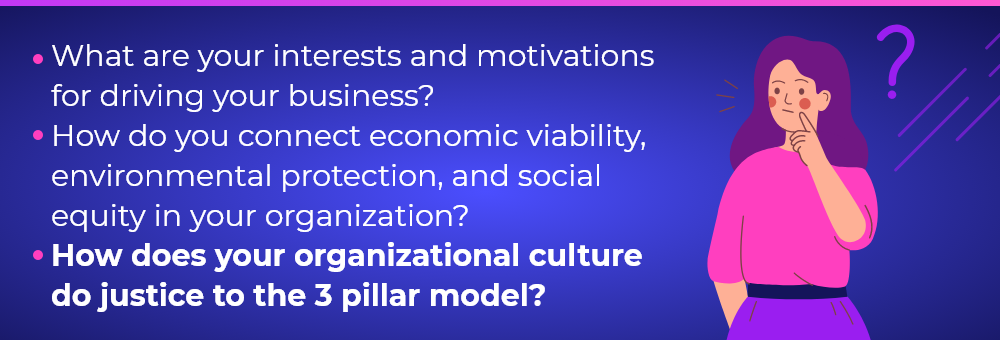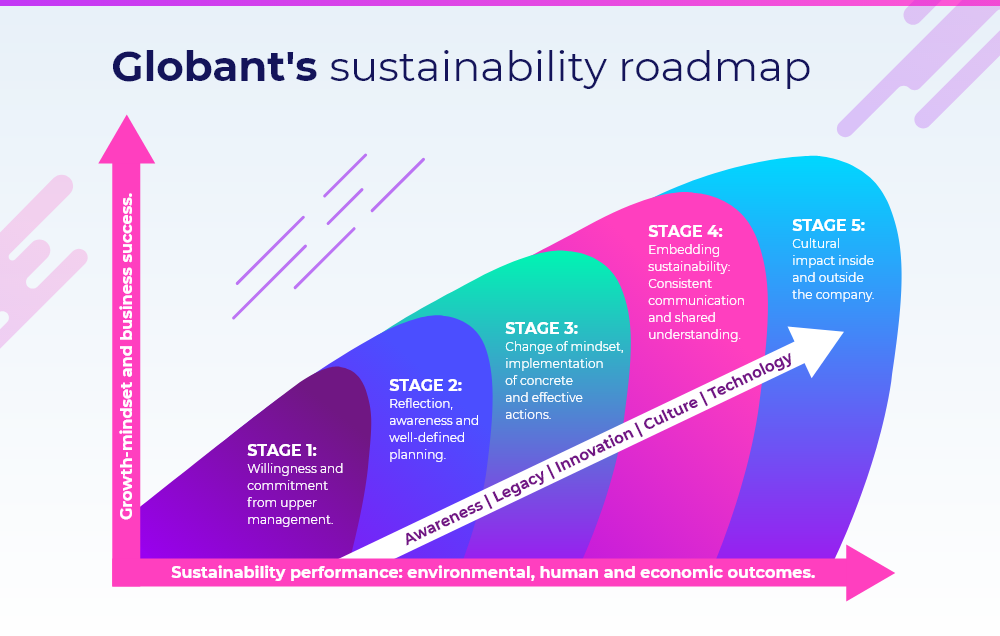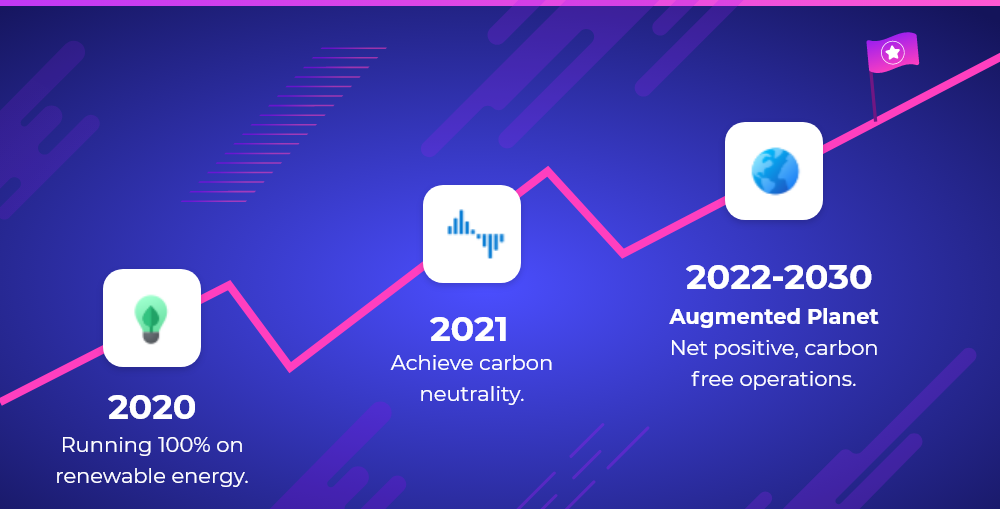Corporate sustainability: navigate your green way forward
Written by María Eugenia Raffaele
“Being a good human being is good business.” — Paul Hawken.
The only possible way to keep your business moving forward is to make corporate sustainability and carbon-thinking top of mind in the entire organization. The key? Open your eyes, make it cultural and get everyone involved.
It’s hard to believe that making the planet a cleaner place is not everyone’s top priority. Many individuals, organizations, and governments are increasingly embracing sustainability considering it an essential part of their policies. However, business leaders still find it challenging to proactively commit to corporate sustainability and move from fast profit linear models at the expense of the environment to sustainable practices and technological eco-innovations.
Corporate sustainability seems to be at a crossroads nowadays. Although 90% of top managers consider sustainability highly important, only 25% have created effective strategies in their business. Actually, this report from Bain shows impressive results about the corporate sustainability initiatives and programs implemented so far:
- Only 2% achieved or exceeded the expectations that were set, and
- 81% settled for mediocre performance
It’s easier said than done, right? If change is difficult, then corporate sustainability change seems to be even harder. As usual, the central issue here is culture. Isolated environmentally-friendly initiatives won’t have any effect on the planet, your company, or the community unless culture leads the way. This surely doesn’t happen overnight, but intention, willingness and awareness are the first steps that will make a difference in the future of your company.
What is corporate sustainability?
Corporate sustainability was defined by the UN in 1987 as “meeting the needs of present generations without compromising the needs of future generations”. Now, before planning sustainable approaches, companies have to consider how each of their actions will affect the environment, society, and the economy. Let’s explain this concept through the following 3-pillar model.

Environmental pillar
No matter what goods you produce or service you offer, you probably rely on natural resources such as land, water and/or energy, right? So, either due to water usage, carbon footprint, or packaging waste, your business does have a negative impact on the environment, and emissions must be abated or balanced to meet the goal set by the Paris agreement: limit global warming to a pre-industrial baseline. The environmental pillar, among other things, implies that companies must proactively rethink their cultural mindset and plan long-term corporate sustainability strategies and initiatives, which is a process many upper managers are still not willing to undergo.
Social equity
The social pillar of a sustainable organization is related to equity and to the company’s compromise with prosperity for Humanity. It implies building a culture based on diversity and inclusion, with equal opportunities and a voice for every individual. An employee-centered culture treats people fairly and focuses on engagement and retention strategies. Growth-mindset organizations with flexibility and development opportunities for all respond to the social pillar of sustainability because they are able to recognize their impact on their employees and the community they are part of.
TAKEAWAY
In this context of global crisis and remote work, leaders play a key role in responding to the social pillar of sustainability. Building a culture based on collaborative teamwork, trust and recognition will make employees feel more commitment and loyalty towards your company.
Economic pillar of sustainable development
This pillar is related to the company’s strategies that promote the use of socio-economic resources to their best advantage. This goes far beyond ensuring a profitable business, rather, it’s about making sure your business doesn’t have a negative impact on the social and/or the environmental pillar. This implies, building a sustainable organizational culture that makes the most of innovation and technology to promote the use of natural resources in a responsible, transparent, and effective way.
Culture comes first
I suggest you stop reading and reflect upon these 3 questions:

No matter how much effort you put to be a sustainable organization, if you don’t make sustainability a pillar of an inclusive and collaborative culture, you’ll end up being part of the 98% of companies that can’t meet the expectations of their initiatives. A sustainability-oriented organizational culture is the key to meet the sustainable principles you pursue.
TIPS for top managers
Once you raise awareness on the importance of corporate sustainability and are willing to start creating your green way forward, make sure you:
- Promote constant reflection and awareness among all your employees
- Encourage participation in the planning process (your future corporate sustainability initiatives will become more significant for them this way!)
- Changes are dynamic: enhance ongoing learning and training on the subject to keep people updated on environmental changes and needs.
- Embrace the use of technology and AI to implement innovative initiatives
- Keep an open mind and be positive all the way – becoming a sustainable organization shouldn’t be a burden. Rather, it’s an opportunity to make a difference in the environment, your society and your future profit.
Why sustainability matters
Although many companies are under great pressure to present corporate social responsibility reports that respond to the 3 pillars, many top managers still decide to put the matter off for later as they believe it won’t affect their business, at least in the short term. Well, they can’t be any more wrong.
Actually, according to a consumer pulse survey, the top issues people identify with when it comes to making decisions about the products and services they consume are:
- How the company treats its own employees
- How the company treats the environment
- How the company supports the communities in which it operates
Generations Y and Z seem to be leading the pack here. Their increasing concern about looking after our planet not only conditions their choices as consumers, but also impacts on the professional decisions they make. Actually, 62% of Generation Z, prefer to buy from sustainable brands and they share the same view with the 70% of millennials who prefer to work for sustainable organizations that represent their values.
To put it simply, if you don’t start rethinking your culture and reinvent your mission and business approach, you run the risk of becoming the “slow giant that failed to innovate”.
Globant’s roadmap to corporate sustainability
By now, it’s crystal clear that environmental awareness is NOT an option. However, given that many companies lack the experience or knowledge on how to build sustainable organizations, I hope Globant’s experience can inspire you to plan your next move.

I belong to the 70% of millennials who choose to work in companies that do have a sustainability plan or at least are on their way to do so. I believe corporate sustainability programs are fundamental, but also being given the opportunity to contribute to the company’s initiatives through its culture, makes me feel part of something big.
At Globant, becoming a sustainable company took a process of true awareness, reeducation, commitment and teamwork to plan strategies that respond to the three pillars of sustainability. Our guiding light? The ultimate goal of taking our culture to the next level and making an impact on present and future generations.
“At first, sustainability represented a challenge, but then, we saw it clearly… it was actually an opportunity to rethink who we are and where we are heading as a company and as human beings”.
Santiago Fontanarrosa, VP of Technology – Sustainable Business Studio.
The process was challenging and it took hard teamwork, but we finally saw it clearly: this was an opportunity to make the most of technology and AI to achieve substantial measurable contributions to our industry and value chain.

Since 2020 Globant has been using 100% renewable energy, and its long-term commitment is getting stronger, as the organization aims at achieving carbon neutrality by 2021 and being net positive, carbon-free operations by 2030. All this work is part of the Be kind initiative, a sustainability program based on 3 key statements: be kind to the planet, be kind to your peers, and be kind to humanity.
So, how did we make it cultural? Through the Be Kind to the Planet initiative, every Glober is involved and responsible for transforming the company into a net-positive environmental agent by carrying out their daily activities within sustainable parameters. The key is creating awareness across the company – top-down and bottom-up. This way, Globant makes sure it continues planting the seeds that will become the drivers of climate change within the company in the future.
“A sustainable business is a legitimate business”
Elena Morettini, Managing Director Sustainable Business Studio at Globant.
Corporate sustainability is here to stay and we’re all in this together. This is not about the future of your company, but about the future of the younger generations that inhabit our planet. If you feel willing to take the next step, our specialists can give you further insight and guidance to find the tools and strategies you need to become the company that makes the world proud.